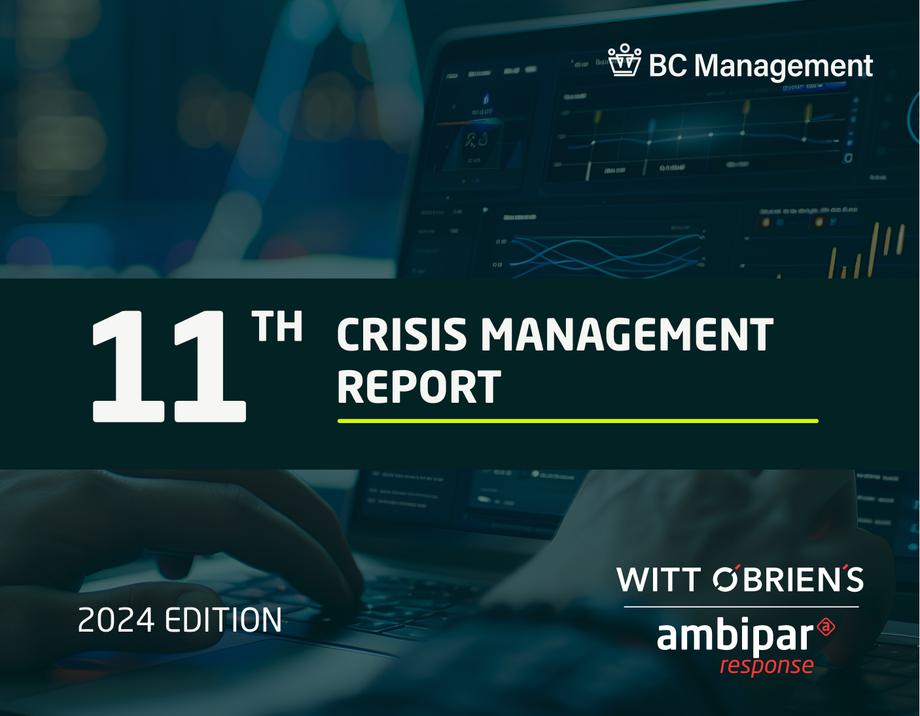
[Download the Full Complimentary Report]
Confidentially Participate in this Study by Feb 28, 2025, to Receive a Tailored Dataset [Click Here to Learn More]
Video recording was provided by the Association of Continuity Professionals
The Crisis Management Report offers a comprehensive summary of the extensive data collected in the 11th edition of our study. It examines the effects of various crises on organizations, including operational downtime, employee impact, organizational losses, and financial damage. Additionally, the report assesses how organizations prepare for crisis management and use lessons learned to strengthen their resilience strategies. Here is an executive summary of this year’s report and some key findings we wanted to share with you.
Gaps in Pre-Planning – Being prepared is key, and while 71% of organizations indicated they were either “extremely prepared” or “prepared” for crises, the data told a different story.
- Organizations are least prepared for a supply chain disruption (38%), financial market disruption (46%), ordisgruntled employee (64%). While organizations have broadened the scope of their programs, with significant increases in addressing specific risks such as supply chain disruptions (+18%) and workplace violence (+12%) from 2023 to the present, only 9% and 5% of organizations anticipate improvements in liquidity and credit issues, respectively.
- 26% of all organizations use a standard definition of ‘Crisis’ to ensure the appropriate level of response and management. Additionally, only 30% of all organizations document all areas of executive risk acceptance and perform annual reviews.
- Using a mobile phone was the top method (91%) to communicate throughout a crisis, but only 71% noted that their plans are accessible in a mobile format.
- The top challenges noted for corporate-level crisis management teams are 1) Clarity on when a crisis management team is notified and activated, 2) inability to focus on the strategic ‘what’ to do versus devolving into the operational ‘how’ to do it., and 3) agreement on the level of transparency in crisis communications.
Top Crises & the Impact Ratings – This year we continued with the same assessment to not only highlight the top crises recently impacting organizations, but we also assigned a crisis impact rating based on the frequency, full activation rating, advance warning, impact on employees, geographic scope, percent of critical systems impacted, business resumption period, and the estimated financial losses. The full details are included within the report, but here are the most notable insights.
- Technology disasters had a greater impact on organizations compared to natural, accident, or human/business disasters, as three out of the top five crisis impact ratings were attributed to technology-related incidents (software issues, cyber attacks, and network/communication outages).
- Software issues surpassed other crises in impact, receiving the highest ratings with a score of 10 for employee and geographical impact, and a score of 9 for frequency, full program activation, and impact on critical systems.
- Cyber attacks ranked as the second most impactful disaster, receiving a score of 10 for minimal advance warning and estimated financial losses, and a score of 9 for geographical impact scope and recovery time to normal business operations.
Estimated Financial Losses Following a Crisis – On average, 57% of respondents reported difficulty in estimating financial losses after a crisis. However, for those who were able to calculate the loss, the data revealed the following.
- Cyber attacks led to the highest estimated financial losses for organizations, followed by network/communication outages, ice storms/ winter weather, and supply chain disruptions.
- 83% of organizations reported that their executives were highly involved in managing crises that resulted in estimated financial losses of over $5 million.
All organizations that experienced a crisis resulting in estimated financial losses exceeding $5 million reported being affected operationally and/or by supply chain disruptions impacting product or service delivery.
Balancing Technology & Elevating Organizational Resiliency – Being truly "resilient" requires a holistic approach. Organizations are stretched thin as they strive to balance technological advancements while enhancing their resilience management by integrating with other risk disciplines, improving supply chain resilience, and driving program metrics. Given that technology disasters had the highest impact ratings on organizations, it’s no surprise that more are increasing investments in technology improvements and software automation.
People remain the greatest asset in building resilience; however, fewer organizations plan to increase full-time, permanent staff next year, down 12% from 2023. In contrast, more organizations expect to maintain current staffing levels, up 11% from last year. While uncertain markets may lead to a hiring slowdown, the work still needs to get done. As a result, there has been a slight uptick in the use of third-party consulting services to support resilience management strategies.
How can this report benefit your program and organization? This report is a broad analysis of a segment of the data, illustrating how the Resilience Management profession is viewed and what we can learn from these study results. Although this is simply a baseline of the trends in our industry, we hope you leverage this report to present data findings to your executive management to increase the visibility and commitment of your program. Enclosed you will find a great deal of data, though it is impossible to display everything, which is why customized dashboard reporting specific to your organization is essential to obtain a clear understanding of other “similar” organizations. A feature of the customized dashboards is providing a detailed analysis specific to your industry or by organizational revenues, which not only allows you to benchmark your own program specific to your demographic but also provides an opportunity to create a roadmap for your program based on effective peer-based models and supporting data. Our customized dashboards will be made available to professionals who confidentially participated in the 11th Edition Crisis Management Study.
Since 2001, we’ve been conducting data research to increase the understanding of the analytical underpinnings of our profession. As we continue our efforts to advance the knowledge, insights, and value our business provides to the maturity of our profession, we know that to that end, the understanding of how to increase resiliency and better understand how the profession is evolving is of key importance. Thank you to all who responded to this survey, our advisory board, and to Witt O’Brien’s team for their efforts in developing this valuable report. We hope you enjoy this report, and we are available to discuss customized versions to meet your needs.
Video recording was provided by the Association of Continuity Professionals

Cheyene is a global leader with over 25 years dedicated expertise specializing in the resiliency profession. She founded BC Management, Inc. in 2000 and joined Witt O’Brien’s in 2022 as a Managing Director, Talent Management & Research Analytics. Within Witt O’Brien’s (an Ambipar company) she is responsible for overseeing staffing strategies and data research analytics for clients globally in addition to providing career assessments and coaching expertise. She previously served on the board for the Association of Continuity Professionals (ACP) of Los Angeles and Orange County in addition to the National Board for the ACP and the Editorial Advisory Board for Continuity Insights. Cheyene was also the recipient of the ACP Lifetime Achievement award in 2024, the inaugural ACP Hall of Fame award in 2006, and in 2010 she was awarded an Honorary MBCI by the Business Continuity Institute (BCI).